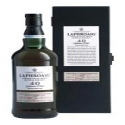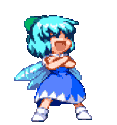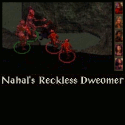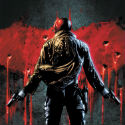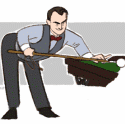|
You can't learn how to play NEXT from reading the book straight, same with 3e and 2e AD&D. People really underestimate how much the video games were doing the teaching.
|
|
|
|

|
| # ? May 15, 2024 05:30 |
|
I finally got a chance to read through the DMG, and I've listed down my impressions and things that jumped out at me. Sorry if it's a little stream-of-consciousness-ish. === There's a rule for Mob Attacks: if you have lots of monsters attacking the same target, you calculate the d20 roll needed to hit the target, and then you assume x number of hits. That is, if you need a 1-5 on a d20 to hit, then you just assume that one of the dozen pack rats will hit. If you need a 6-12, then 2 rats will hit, and so on. The gridded tactical combat rules have examples for both squares and hexes. Flanking rule: you have Advantage on melee attacks against a flanked target Proficiency dice: instead of adding a flat +2/3/4/5/6 to rolls that you're proficient in, you can use d4s to replace +2, d6 to replace +3, d8 to replace +4, d10 to replace +5 and d12 to replace +6 for PCs and NPCs Skill variants Ability check proficiency: instead of skills, you can select two attribute scores and you have proficiency in any skill check using that proficiency Background proficiency: you have proficiency in anything that your character background suggests you would be good at (which is pretty much exactly how the Microlite 5E draft called it) Personality trait proficiency: you make up 3-4 different "personality traits" that strikes me as resembling FATE aspects, and you have proficiency in anything you do that invokes those traits Hero points: Players start with 5 Hero Points that they can use to add a d6 to any attack roll, ability check or saving throw. Their Hero Points are reset to [5 + Level/2] whenever they level up. This would seem to be something to be used in conjunction with Inspiration - I'm guessing adding 3.5 to rolls can mess with Bounded Accuracy so you're not supposed to be able to bank these regularly. Healing Surges: as an action, a character can spend up to half their hit dice to heal in the middle of combat. They can't do this again until after any Rest. The rule also suggests having Long Rests restore all hit dice (instead of the default half) and Short Rests restore 25% of all hit dice (instead of the default none). The rule also suggests turning the Healing Surge action into a bonus action "for a more superheroic feel" There's also healing rule variants where you don't heal unless you have access to a Healing Kit, or one where Long Rests don't naturally restore HP by themselves - they just restore Hit Dice and then you have to spend the Hit Dice to heal and then you have to re-rest to earn them back, but my god that just adds tedium that everyone is guaranteed to fast-forward through anyway. Rest variant: already mentioned before, but there's an Epic Heroism rule where Short Rests are 5 mins and Long Rests are 1 hour, or Gritty Realism where it's an 8 hour / 1 week configuration. Plot Points: every player has 1 plot point per session that they can play to either introduce an element that is accepted to be true, or to add a complication, or to assume the role of DM. There's an initiative rule variant that allows you to factor in weapon speed. This is a throwback to AD&D, right? Jesus Disarm, Marking, Bull Rush, and Tumble can all be added back into the game as standard combat actions. Marking is a little different: if the marked target triggers an opportunity attack from you, your opportunity attack has Advantage and doesn't consume your 1 reaction/round. I kind of feel like the Fighter is getting shortchanged since these are combat actions that everyone has access to, if added back in RAW. Cleaving (excess melee damage spills over to adjacent creatures) can also be added back into the game, but again accessible to all characters. There's a morale system, and it very closely resembles BECMI: Being surprised, being reduced to half HP or less for the first time, being unable the harm the characters will trigger a morale check on individual creatures Everyone being surprised, the leader getting killed, half the whole group getting killed will trigger a morale check on the whole group There's a whole section on creation random dungeons from tables, but I can't imagine that anyone who already has any other D&D-type RPG book would find this one particularly earth-shattering, although of course if this is your first RPG then well and good. The first third of the book is about world-building, both as your own and detailing D&D's universe(s). Again, useful as babby's first DM guide. The treasure section of the book has random tables for both treasure drops for individual small encounters as well as hoards, and pages and pages of magical items, but just like the random dungeon section I can't help but feel I've seen this all before whether in the Rules Cyclopedia or OSRIC/AD&D or Labyrinth Lord.
|
|
|
|
quote:Healing Surges: as an action, a character can spend up to half their hit dice to heal in the middle of combat. They can't do this again until after any Rest. The rule also suggests having Long Rests restore all hit dice (instead of the default half) and Short Rests restore 25% of all hit dice (instead of the default none). The rule also suggests turning the Healing Surge action into a bonus action "for a more superheroic feel" Wow check out how badly they missed the point on healing surges. quote:There's an initiative rule variant that allows you to factor in weapon speed. This is a throwback to AD&D, right? Jesus Yes and initiative was one of the worst things in that system if you bothered with it at all beyond "Uh, just roll."
|
|
|
|
gradenko_2000 posted:Flanking rule: you have Advantage on melee attacks against a flanked target
|
|
|
|
Jackard posted:Does it describe what a flanked target is? Yes. Basically the same as in 4E: if you're on opposite sides of the target / a line between two characters passes through the center of the target, it is flanked
|
|
|
|
gradenko_2000 posted:Yes. Basically the same as in 4E: if you're on opposite sides of the target / a line between two characters passes through the center of the target, it is flanked Are there facing rules? If so, how does flanking interact with them?
|
|
|
|
OneThousandMonkeys posted:Wow check out how badly they missed the point on healing surges. Its kinda magical to see how they don't understand the previous version of their game in the slightest.
|
|
|
|
Healing surges were an elegant mechanic that worked well until level ~16 or so in 4E, its a shame that whoever wrote the section in the DMG presented them as "You just heal! Free healing!" instead of as a pacing and resource mechanic.
|
|
|
|
I've started to wonder if maybe Monte Cook was the one trying to bring in 4e-isms, because at least when he re-invented passive perception he got it right. Every single time Mearls has tried to talk 4e he's gotten it wrong.
|
|
|
|
Still reading through my DMG, but initial impressions aren't bad. There is a lot here to read through and it will take a while to absorb. I'm looking into the 'core' stuff first like monsters and items before messing with the optional rules suggestions. I pretty much went straight to the monster creation rules to see wtf that table someone posted a while back was about. It shows average damage by CR, but that gets divied up into monster attacks, including total expected damage for area effects, or averaged by 3 rounds worth of attacks if something like a dragon with a recharging breath and claw/bite routines.
|
|
|
|
ritorix posted:I pretty much went straight to the monster creation rules to see wtf that table someone posted a while back was about. It shows average damage by CR, but that gets divied up into monster attacks, including total expected damage for area effects, or averaged by 3 rounds worth of attacks if something like a dragon with a recharging breath and claw/bite routines. I'm really interested to see how this will work. Hopefully I get my copy soon. Can anyone who has it be bothered trying to make (for example) an Ogre using the rules in the book, and then compare the result to the Ogre in the MM? Elector_Nerdlingen fucked around with this message at 00:07 on Dec 10, 2014 |
|
|
|
Short version, let's say you want to make a CR3 monster. 1) Start with defense. CR3 = AC13 and 110HP. 2) Offense: +4 attacks for 22 damage. So you can divide that into two attacks that average 11 damage each, like uh 1d8+6. Close enough. Reverse engineering isn't as simple, you have to average out the defense and offense. So here's a CR8 assassin: 78HP, AC15, 13 damage 1/turn + two attacks for 6+24(DC15CON). Total of about 13+24+6=73, or about CR11. It's low HP put its defensive CR at about CR1, then adjust by 1 for the 2-point higher AC. So CR2 defense, CR11 offense, CR6.5 total. I don't think I'm doing this entirely right. I started by saying this was the short version, lol.
|
|
|
|
As someone who never played 4e, I just went to read up a little on 4e healing surges vs 5e hit dice. (Healing surges are to recover from encounters or as an alternate resource for some powers. 5e hit dice are basically potions. Is that right?) In this process though I found some forum where a bunch of grognards were whining early on in Next development about the healing mechanic because "Healing surges were an awful mechanic." Main whines seem to be "that's what healing spells are for!" and "my verisimilitude!" The former is stupid because it's not like casters need more power or stuff as their sole domain. The latter being the omnipresent issue of people viewing HP as meat. Are these widely held opinions outside of the 4e friendly wonderland that is this forum?
|
|
|
|
Monster HP by CR is also adjusted based on resistances and crap. This is complicated. Ok let me try this again with something simple. That ogre. 59HP, AC11, hits for 13. CR2. 59HP is in the CR1/2 range. The AC is 2 lower, so you adjust down by 1 CR rank, so it's defensive CR is CR1/4. Offensively, 13 damage average puts it at CR1. The attack bonus is 3 higher than CR1, though, so that inflates offensive CR by 2 points to CR3. Then you average the 3 and the 1/4, which gives 1.625. Round ritorix fucked around with this message at 00:32 on Dec 10, 2014 |
|
|
|
mango sentinel posted:As someone who never played 4e, I just went to read up a little on 4e healing surges vs 5e hit dice. (Healing surges are to recover from encounters or as an alternate resource for some powers. 5e hit dice are basically potions. Is that right?) Yes, lots of people out there (mostly people who exclusively play d&d games ive found) think that HP is physical damage you are dealing and that it wouldn't make any sense to recover from it without magic.
|
|
|
|
kingcom posted:Yes, lots of people out there (mostly people who exclusively play d&d games ive found) think that HP is physical damage you are dealing and that it wouldn't make any sense to recover from it without magic.
|
|
|
|
mango sentinel posted:Well I know that's an issue. I meant more the belief that Healing Surges are a bad mechanic. Anything that smooths out encounter balance makes players feel less limited without breaking the game seems like a slam dunk good thing. Its in 4e so yes, people actually dislike this mechanic.
|
|
|
|
mango sentinel posted:Well I know that's an issue. I meant more the belief that Healing Surges are a bad mechanic. Anything that smooths out encounter balance makes players feel less limited without breaking the game seems like a slam dunk good thing. Anyone who thinks Healing Surges are a bad mechanic are broken people. Pre-healing surges (and now in Next) HP is unlimited; you have as many potions or wands of cure light wounds as you can carry. Any restriction on this healing has to be from the DM or the world. In a fight, however, you can't heal well; the only thing wortwhile is the Heal spell at higher level. Pacing and scaling on healing spells didn't really match up to the HP damage being dealt by monsters. This poor design of previous D&D is now back in Next. With healing surges, two things happened: one, the total amount of HP you could tap into in a given day was limited. Secondly, healing in combat suddenly became a realistic proposition - you were able to use this healing resource in combat as it scaled with your HP (each surge is base 1/4th of your total HP, some races/feats etc modified this), and generally the math on monster to-hit and damage was very tight in 4E. This was a complimentary, elegant system. Some people hated it because healing comes from Magic Only and thats how they always did it. Some people hated it because it necessarily made the game less lethal; Mearls house-ruled Healing Surges out of existence in his 4E games because he wanted players to have their basic HP and-that-was-it; he didn't like the Adventuring Day being tied to Healing Surges left, he wanted it to be tied to spells remaining and just in general be higher lethality. In 4E, there are no monsters that can just kill you outright; it wasn't a design concept. Anything that could do enough damage to kill you outright would also be unhittable and miss you only on a natural 1 due to the level scaling. If you wanted higher lethality, and that gameplay feel/style, removing or reducing healing surges was a step in that direction. I think that is a pretty fair look at why people didn't like healing surges without name-calling. Basically they wanted to play a game with, for lack of a better term, less empowered (not necessarily powerful, but capable of interacting with the game world on their own terms) PCs. 4E essentially empowered all characters to do this within the framework of the rules - you didn't have to use weird magical tricks and loopholes. Lots of players, however, got their kicks out of 3.X from doing exactly that, trying to gain a degree of power over the world via abuse of the game rules, because a vanilla 1-20 character had no agency unless they were a Cleric, Druid, or Wizard in 3.X. All of a sudden, everyone was equal under the game rules. That is a very different mental game - you no longer are trying or have to or even need to game the system. And, get this - really, truly gaming the system in 4E requires the participation of *other players at the table*. You couldn't craft the 1-20 build that did its stupid gimmick and didn't rely on anyone else and get that kick anymore. As a DM, I was delighted at this, but I know a few players who made the 3.X->4E transition and basically were sad that the degree of power gaming possible in 3.X in relation to the relative power of the default classes and other players was no longer there. You can still do nasty tricks and combos in 4E, but the absolute best ones rely upon abuse of the action economy, and those require other players to maximize. Laphroaig fucked around with this message at 00:46 on Dec 10, 2014 |
|
|
|
Laphroaig posted:It was good and solved problems. Ftfy.
|
|
|
|
gradenko_2000 posted:I finally got a chance to read through the DMG, and I've listed down my impressions and things that jumped out at me. Sorry if it's a little stream-of-consciousness-ish. Mob attacks seems sensible at first blush until you realise that advantage is much more difficult to calculate for those rules than any form of static bonus would be. Hexes, flanking, fine. Dice... whatever, to each his own. Alt skills seem fine too. Hero points are nice. Healing surges... completely miss the loving point so hard it's genuinely not even funny. And at a brief glance, it goes downhill from there. There are some bits I might back-rule into 4e, but not many.
|
|
|
|
kingcom posted:Ftfy. Healing Surges made the game more predictable and less randomly lethal. A more predictable game and a less randomly lethal game puts more power into the hands of the players uniformly. DMs who wanted more lethality didn't like it, and players who got a kick out of maximizing their own PCs relative to the PCs of others didn't like it. quote:Mob attacks seems sensible at first blush until you realise that advantage is much more difficult to calculate for those rules than any form of static bonus would be. Just do Advantage is +5, Disadvantage is -5. I know thats only true for the middle of the chart, but its a useful rule of thumb and can be resolved quickly.
|
|
|
|
(6:32:50 PM) king_com: do some more (6:32:56 PM) Ritorix: gross (6:33:08 PM) king_com: ooh oh (6:33:12 PM) king_com: do the intellect devourer Monster Manual Intellect Devourer: CR2 with 21HP, 12AC, damage resistance, hits at +4 for 7 damage and DC12 save or 11 damage or go loving braindead (if target Int<=3d6, it goes to 0 and stunned and can be devoured). Defense: Effectively CR1/4 with the resists factored in. Offense: 18 average damage matches to CR2. The devour feature is basically impossible to calculate so I'll compare it to this handy 2-page list of monster features and look for something that does insta-death or permastun or whatever. gently caress, I don't see anything appropriate. Guess I'm handwaving this poo poo, so I'll just double the offense CR to 4. Average out the 4 and the 1/4 gives 2.125, rounded down to CR2. It works!
|
|
|
|
who gives a gently caress about a formula
|
|
|
|
Laphroaig posted:who gives a gently caress about a formula nobody will give a poo poo about a formula.
|
|
|
|
The whole section on how to adjudicate areas of effect in TOTM is kinda nuts. If something is a cone, you take the size and divide by 10, rounded up. So if you burning hands at a few goblins in TOTM, you could just declare it hits 2 of them (15/10=1.5, round up to 2).
|
|
|
|
My personal beef with healing surges was that it made healing a non issue. You get so many that you never needed healing potions or heal spells. There was no real reason for any outside healing. On top of this, all you needed was a long rest to get them back. I did enjoy 4e during its time, but healing surges as they were, are a bad mechanic. Second wind was awesome, as was the warlord and all the other forms of nontraditional healing. Surges were just bad.
|
|
|
|
EDIT: I'm a moron.
|
|
|
|
gradenko_2000 posted:There's an initiative rule variant that allows you to factor in weapon speed. This is a throwback to AD&D, right? Jesus Let me guess... daggers have a good weapon speed and greatswords have a bad weapon speed? Because the ability to strike first depends on weight rather than reach and the ability to literally be able to land a hit from a distance where the opponent cannot? Elblanco posted:My personal beef with healing surges was that it made healing a non issue. You get so many that you never needed healing potions or heal spells. There was no real reason for any outside healing. On top of this, all you needed was a long rest to get them back. I did enjoy 4e during its time, but healing surges as they were, are a bad mechanic. Second wind was awesome, as was the warlord and all the other forms of nontraditional healing. Surges were just bad. You... you do realize that those potions and spells are what allow you to use those healing surges, yes? Like, you have one single use of a healing surge per encounter through the Second Wind action and anything beyond that will need a spell or potion or similar effect? I literally cannot fathom how anyone can say that healing surges make healing a non-issue. Healing surges are what makes healing possible. It's like saying walls are a non-issue because of bricks. Sage Genesis fucked around with this message at 01:18 on Dec 10, 2014 |
|
|
|
Elblanco posted:My personal beef with healing surges was that it made healing a non issue. You get so many that you never needed healing potions or heal spells. There was no real reason for any outside healing. But that's not how healing surges worked. On your own, you could only spend 1 per battle and you had to spend your standard for that (unless you're a dwarf). Healing spells and potions allowed you to spend surges multiple times and as a minor.
|
|
|
|
Yeah, they were a resource that had to be unlocked by spells or abilities or potions, though you got one free per battle as a standard (second wind). Granted if there's a party member that can efficiently dispense those surges the party becomes nigh-unkillable, but it's a good system that ties several concepts together elegantly.
|
|
|
|
Elblanco posted:My personal beef with healing surges was that it made healing a non issue. You get so many that you never needed healing potions or heal spells. There was no real reason for any outside healing. On top of this, all you needed was a long rest to get them back. I did enjoy 4e during its time, but healing surges as they were, are a bad mechanic. Second wind was awesome, as was the warlord and all the other forms of nontraditional healing. Surges were just bad. But in every version of D&D there was no reason to use healing in combat given how low it was. It was always an out of combat thing until you got the Heal spell at higher levels. You cant reliably spend healing surges in combat (1 a fight and it cost you your turn) without buying healing potions. Healing Surges intentionally limited the amount of healing you could do per day and it let both the player and GM know how far they could keep pushing before you were done. This was just like in every other version of D&D except everyone tracked their own healing rather than people asking how many spells the spellcasters had left to keep pushing. I completely understand how not having healing be an issue in combat is something you dont enjoy but thats been a pretty traditional D&D thing for a while.
|
|
|
|
djw175 posted:But that's not how healing surges worked. On your own, you could only spend 1 per battle and you had to spend your standard for that (unless you're a dwarf). Healing spells and potions allowed you to spend surges multiple times and as a minor. Yes, sorry I should have been more clear. It's because as soon as the encounter ended, you just use a many surges as you need to get to full. Maybe my players min maxed more or something, but they never seemed to be in too much danger, unless they were deliberately being dumb. Fights were usually, fight and get banged up, second wind maybe, then afterword just use like 2 surges and be back at full. Then they'd have like 8 more, we'd usually end the session before anyone ran out.
|
|
|
|
Elblanco posted:My personal beef with healing surges was that it made healing a non issue. You get so many that you never needed healing potions or heal spells. There was no real reason for any outside healing. On top of this, all you needed was a long rest to get them back. I did enjoy 4e during its time, but healing surges as they were, are a bad mechanic. Second wind was awesome, as was the warlord and all the other forms of nontraditional healing. Surges were just bad. You got so many healing surges that you don't need to use healing potions which consume your healing surges to heal you? Second wind, which lets you use a healing surge in combat at the cost of a standard action, was way better than stupid healing surges which were bad? Warlord healing, which usually comes in the form of "the target can spend a healing surge", was great, but gently caress healing surges? e: Beaten while replying, I guess. e2: Elblanco posted:Yes, sorry I should have been more clear. It's because as soon as the encounter ended, you just use a many surges as you need to get to full. Maybe my players min maxed more or something, but they never seemed to be in too much danger, unless they were deliberately being dumb. In your example, a Fighter (9 surges), has used 3 (second wind, 2 post-combat) to heal up from one fight. After his 3rd fight, he's in trouble. If he's a rogue instead, he can do 2 fights before he's out of surges. Healing surges aren't a per session resource, they're per long rest. If you gently caress with the pacing and regain all your surges after 1-2 encounters, then yeah, I see what the problem is and it's not healing surges. Elector_Nerdlingen fucked around with this message at 01:31 on Dec 10, 2014 |
|
|
|
mango sentinel posted:As someone who never played 4e, I just went to read up a little on 4e healing surges vs 5e hit dice. (Healing surges are to recover from encounters or as an alternate resource for some powers. 5e hit dice are basically potions. Is that right?) That actual problem as you can see right above is that a lot of people never bothered to actually learn what healing surges were, Mearls included apparently.
|
|
|
|
Elblanco posted:Yes, sorry I should have been more clear. It's because as soon as the encounter ended, you just use a many surges as you need to get to full. Maybe my players min maxed more or something, but they never seemed to be in too much danger, unless they were deliberately being dumb. Otherwise you get situations where one player is so badly banged up they can't survive another fight. 4e plays best when the DM pulls no punches so having players be at the top of their game makes sense mechanically.
|
|
|
|
Masiakasaurus posted:That was intentional though, it meant the DM could always assume the party was going into the next fight with roughly full HP. Maybe I'm just too nice of a DM? 
|
|
|
|
Elblanco posted:Yes, sorry I should have been more clear. It's because as soon as the encounter ended, you just use a many surges as you need to get to full. Maybe my players min maxed more or something, but they never seemed to be in too much danger, unless they were deliberately being dumb. Yeah that tended to be how it works. By default healing surges are designed so you can last 4 equal level fights a day before your out. So a single at level encounter tends to not mean much on its own. The thing is, thats also how it worked in other versions of D&D, you ended a fight and spammed cure light wounds on everyone until they were maxed out to full hitpoints. As soon as you got past your shitfarmer level every group would buy a wand of cure light wounds and do the same thing the 4e characters did, except now the party is just paying a tax to play the game AND they essentially have almost infinite healing given the price of cure light wound wands were so trivially cheap you could stock up on a tonne of them. Elblanco posted:Maybe I'm just too nice of a DM? Seems like you might just be used to other D&D edition encounters where you really needed to know when and where to pull your punches. 4e is very much designed so that the DM goes for the jugular and the players can generally keep up. kingcom fucked around with this message at 01:34 on Dec 10, 2014 |
|
|
|
Elblanco posted:Maybe I'm just too nice of a DM? Sounds more like you needed to actually read the rules and understand what your players were doing rather than assuming they knew better.
|
|
|
|
The difference between 4e and 3.x in my experience is that 3.x days are built around charges in your cure wand (which was more or less infinite given how cheap they were) while 4e days are built around healing surges (which are very much not infinite). Furthermore Healing Surges allowed for 4e to do the whole "yo-yo combat" thing, where HP values go down steadily, then get healed to spike back up. In 3.x you got sheer rocket tag, whoever goes first and immediately unloads their stupifying arsenal wins. The thing with D&D is that, for a game who's lengthiest rules have always been about combat, the combat part has always been basically terrible. This lead to people wanting combat to be short so they can "get to the good part," never once questioning why they were having combat if it was "the bad part," because questioning things in this hobby is rude. 4e had much longer and in depth combat - and much more fun combat - except lots of D&D fans hate combat, so 5e is back with fast, boring combat that you slog through as fast as you can to get back to the "good stuff," all while never asking why you would actually play a game built around combat when it has bad combat.
|
|
|
|

|
| # ? May 15, 2024 05:30 |
|
Elblanco posted:Fights were usually, fight and get banged up, second wind maybe, then afterword just use like 2 surges and be back at full. Then they'd have like 8 more, we'd usually end the session before anyone ran out.
|
|
|














